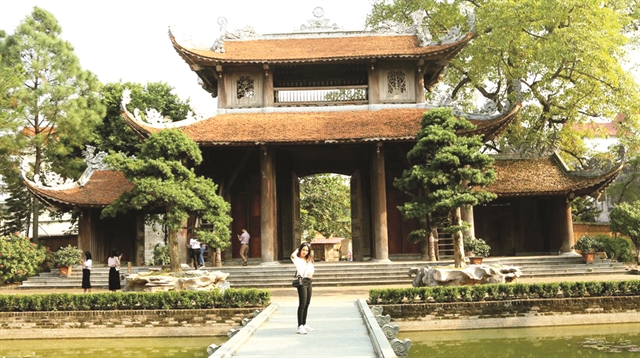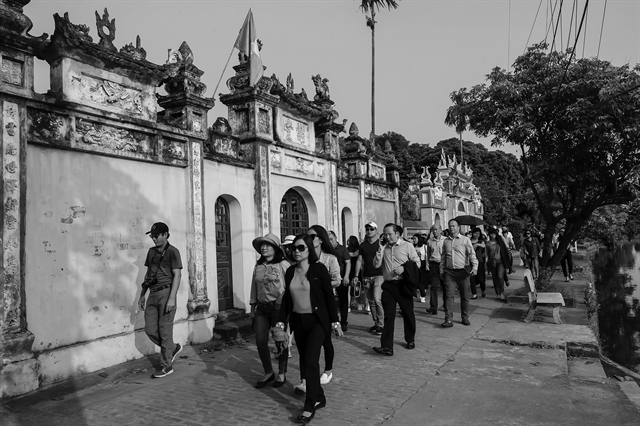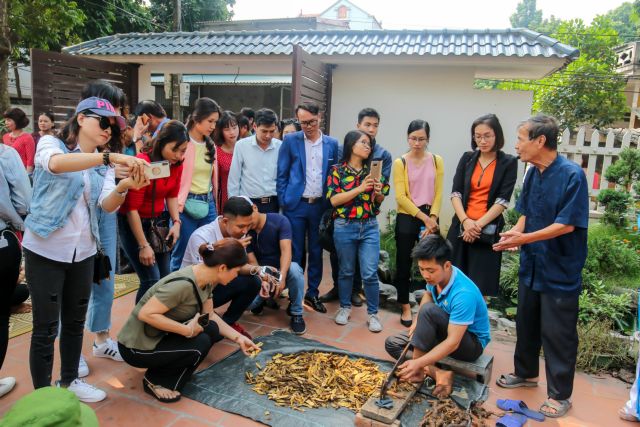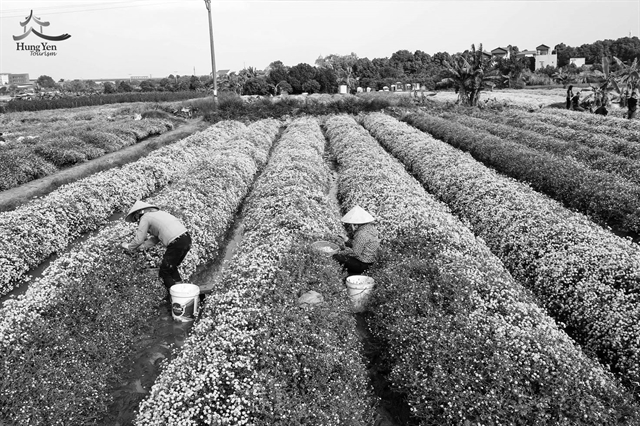
MAKING AN ENTRANCE: The main gate of Nôm Village. Tourists flock here during spring. Photo courtesy of Thanh Bình
Tourism creates thousands of jobs and helps drive the economic and social development of the country. For some provinces like Hưng Yên, leaders are focusing on forming policies to boost the sector's growth. An Vũ reports.
Deputy director of Hưng Yên's Department of Culture and Sports Phạm Văn Hiệu recently led a trip to some of the province's budding tourism destinations.
The first location the group stopped at was Nghĩa Trai medicinal herb village, which is located next to Highway 5 about 20km from Hà Nội.
As a so-called good-natured and idyllic village, Nghĩa Trai is like a country girl hiding from the vanity fair. It has long been known for plain simple herbs like perilla, and marjoram, as well as precious floral medicine such as chamomile, gold money herb and hedgenettle.

FRESH START: Nôm Village in Đại Đồng Commune is an attractive travel destination during spring. Photo courtesy of Hungyen Tourism
Arriving at the village, the aromatic smell of the herbs hits you at once.
Sitting next with a balmy cup of chamomile tea, Trần Tất Thi, the village chief, told reporters: “Planting, processing and practising medical treatment is a lifelong tradition. All the households here grow medical plants to sell or for family use. Over 70 per cent of the village's land is used to grow herbs.”
And he wasn't exaggerating. The village is covered in plants, which the chief told us all have their own special uses.
“Chamomile can treat headaches and vision impairments, while perilla and marjoram can ease swelling. We use the leaves, flowers or roots, and in some cases, all three, depending on the herb."
"Farmers here have grown herbs from generation to generation. It is part of life here. The great thing about them is they don't need pesticide because they can look after themselves.”

STORY TO TELL: The ancient architecture of Nôm Village is well preserved by the people. Photo courtesy of Thanh Bình
Farmer Nguyễn Trần Trung said although growing medical herbs did not earn him very much, the career had been handed down to him by his father, so he wanted to carry on.
“Big farms can earn decent money, while smaller ones can earn enough to make end meets. From each 360 square metre plot we can earn VNĐ7-10 million (US$300-430). Each tonne of herbs fetches VNĐ5-10 million (US$215-430).”
It is not difficult to grow the plants, but it requires meticulous care and certain techniques to guarantee their quality. After harvesting, the plants are chopped into small pieces then dried under the sunlight or a heater.
Small- and medium-sized households produce 30 to 50 tonnes per year, while larger ones churn out hundreds of tonnes.
The village’s major customers are pharmaceutical agencies in big cities like Traphaco and Bảo Long, while some of the produce is exported to China. The village is also known far and wide as a reliable destination for traditional medical treatment.
Nguyễn Ngọc Nga, a frequent visitor from Hà Nội, said she often orders chamomile from Nghĩa Trai Village.
“Whenever my children or I develop symptoms such as eyes fatigue after long hours working in front of the computer, I order a package of chamomile. It has become our favourite drink,” she said.
The most obvious proof of the history of the village can be found on a stone stele dating back to the reign of Emperor Lý Thánh Tông (1023-1072), which records the legend of three generals of the Lý Dynasty. After defeating their enemies, they left the army and returned to the land of Nghĩa Trai to teach farmers how to plant herbs and self-medicate.
Many herbs available on the market are damaged by the sulphur some producers use in the drying process. However, according to director of the Hoa Thiên Phú collective Đỗ Thị Hoa, the process in the village is strictly and hygienically implemented.
“The plants are dried naturally or baked in the oven then carefully packaged. With our traditional experience, households have taken good care of drying and preserving the plants for many years without the aid of preservatives,” said Hoa.

DOWN TO BUSINESS: The village chief said over 70 per cent of the village is used for growing herbs. Photo courtesy of Hungyen Tourism
Herbalist Đỗ Văn Oánh, head of the traditional medicine agency Nghĩa Hạnh, said the plants are helpful for many patients than Western medicine, especially for arthritis and sciatica.
“More and more people are turning to traditional medicine. We believe in what we do, and we have successfully preserved this tradition for generations,” Oánh said.
“At the moment, there are 900 people who plant, trade and produce herbal medicine here, accounting for 85 per cent of the population,” Thi added.
The land of temples and pagodas
Our next destination was Nôm Village, also known as Đại Đồng, which is known for its bronze casting industry, The village is idyllic, quaint and tranquil, and the architecture feels as if it holds the souls of days gone by.
The village is known for its nine-step stone bridge, the quiet Nôm Pagoda and its ancient statues, and a market full of specialties.
The village is home to the 200-year-old Tam Giang communal house, nestling under an old tree, with a well covered in moss and a red brick road meandering by ancient houses, creating a calm and picturesque scene.
Nguyễn Ngọc Chấn, head of the village, said this temple was built towards the end of the Lê Dynasty.
“The communal house is a gathering place for people when we hold weddings or funerals.”
Thái Lạc Pagoda is also a highlight to explore. It is located in Lạc Hồng Commune, Văn Lâm District. Besides Buddhism, the pagoda also worships the God of Vân (Clouds), so it is also known as Pháp Vân Pagoda.
Being built during the Trần Dynasty (1225-1400), the pagoda has undergone many restorations. It bears the typical Trần dynasty architecture, with wooden pillars carved with images of fairies riding a phoenix or playing flutes, and human shaped statues.
Visitor Đỗ Hiền Anh said Hưng Yên was one of the cradles of national legends and souls. "It is such a tranquil and magical land!"
This trip enlightened me to the many features and unique characteristics of this sacred place. They are still well preserved by the locals and in good condition despite the many years that have passed. More than that, the ancient pagoda with its distinctive style is truly a treasure here. If you have chance, take a trip to see how the spirit of the nation was made.
In 1964, the pagoda was named a special architectural relic by the Ministry of Culture and Information.
Hưng Yên is also celebrated for its eco-tourism, with the most well-known being the Ecopark Township. Tourists can experience a fresh, green and multi-architectural space. To serve travellers, Ecopark has set up nine free bus routes to transport tourists from the centre of the capital.

PICK OF THE BUNCH: Chamomille plants are seen everywhere in the village. Photo courtesy of Hungyen Tourism
Looking to improve
Deputy director of the provincial culture department Hiệu said the province still had many sites where tourism could be developed, like Hoà Phong handicraft village, Lạc Đạo rice wine village and Cao Thôn incense making village.
“Over the years, many travel agencies as well as the Hà Nội Tourism Department and nearby provincial local travel agencies have co-operated with Hưng Yên's Tourism Department to organise tours. On these journeys, tourists can feel the fresh countryside air and experience community life and traditional products of the province,” Hiệu said.
Boosting connections
Although there is huge tourism potential, Hưng Yên has failed to make a breakthrough in recent years. According to the director of Sao Mai Tourism Limited Company, Hoàng Phương Mai, the province was only focusing on spiritual tourism, which mainly attracted visitors in spring. Meanwhile, many tourists have a huge interest in simply exploring.
“The province has many advantages which need to be explored. There must be a connection between the local government and tourism agencies to create more exciting tours,” Mai said.
Deputy chairman of the province’s People's Committee Nguyễn Duy Hưng said the province would focus on co-operating with regional provinces that were home to big tourism hubs like Hải Phòng, Quảng Ninh, Ninh Bình and especially Hà Nội.
“We need to promote and mobilise investment to propel the province's potential for tourism development.”
“At present, the province is making every effort to boost tourism at the Hiến Street National Tourism site by focusing on the cultural values of historical sites such as Hưng Yên Street. We are also developing eco-tourism through farming and rural communities along the Red River,” Hưng said. VNS
OVietnam